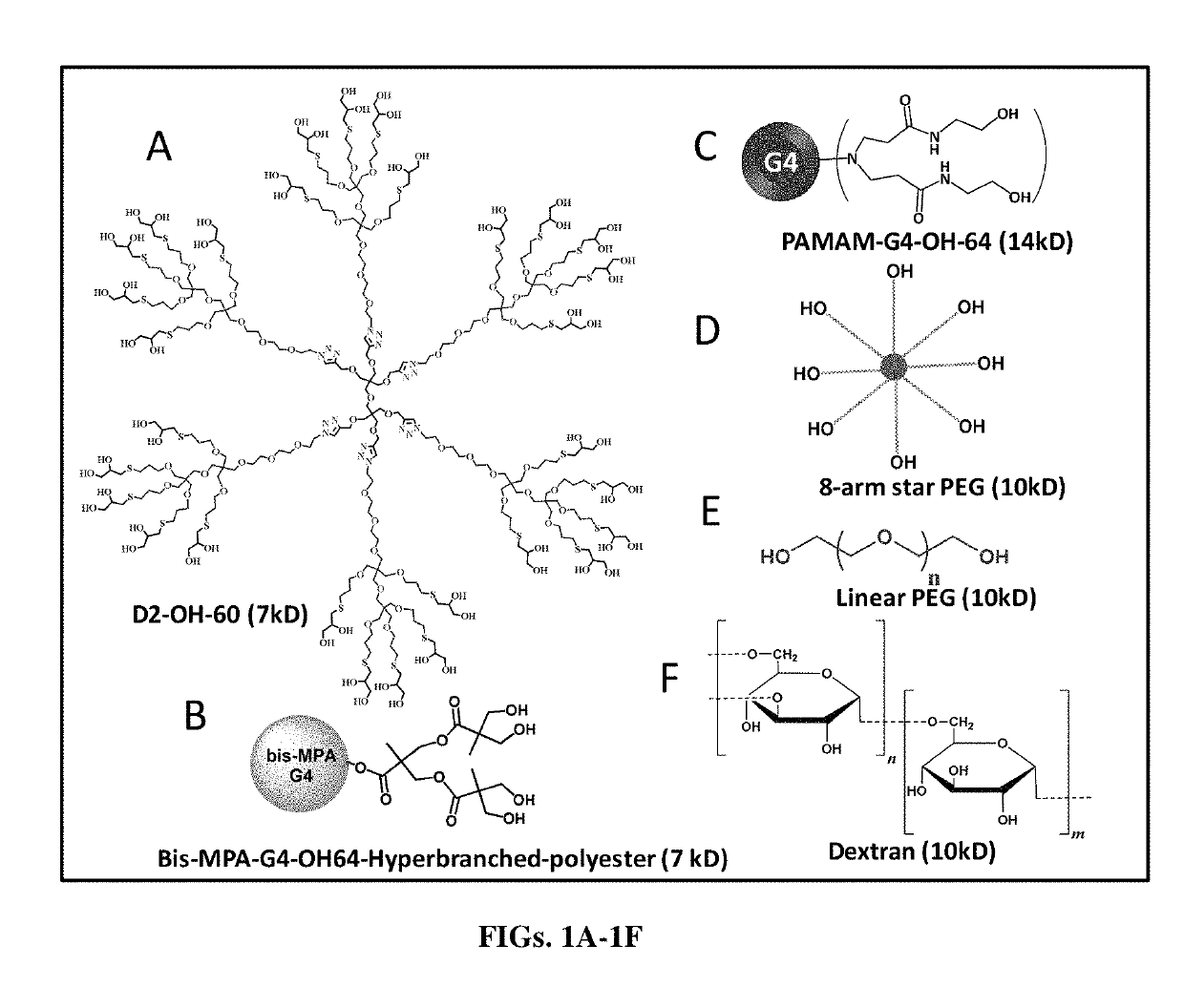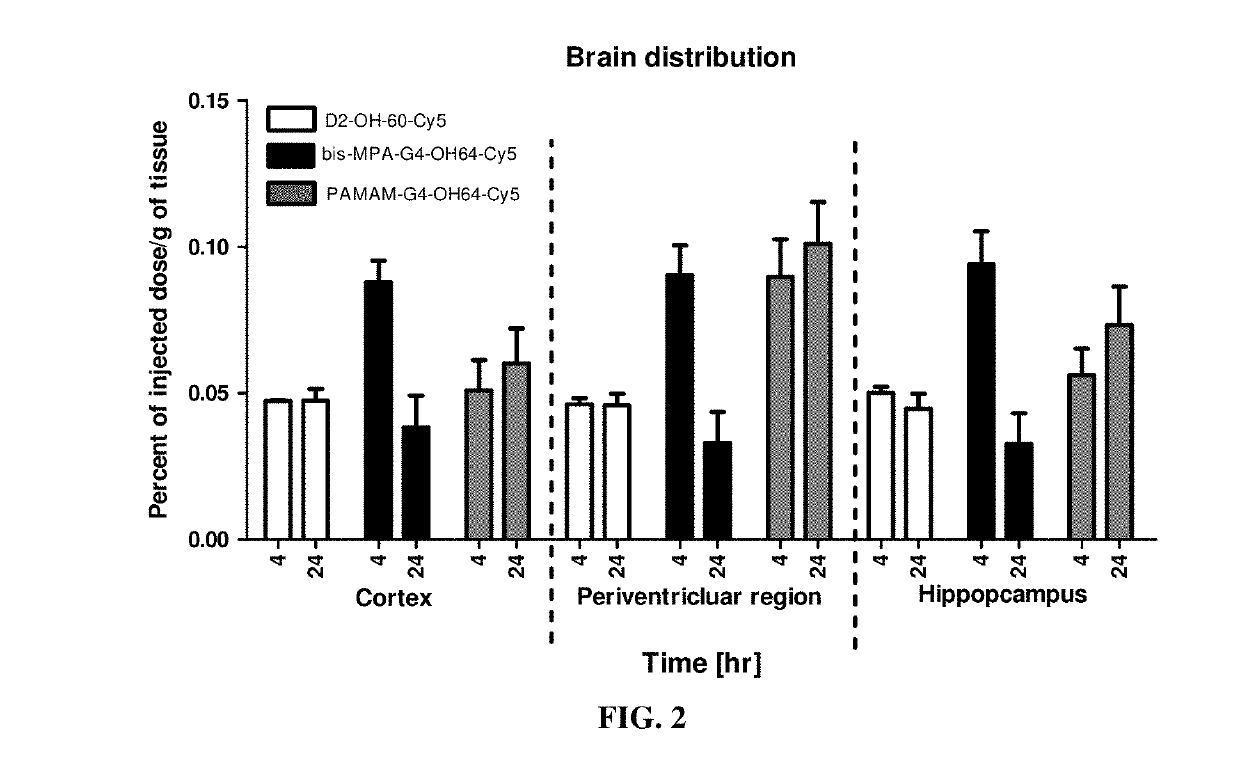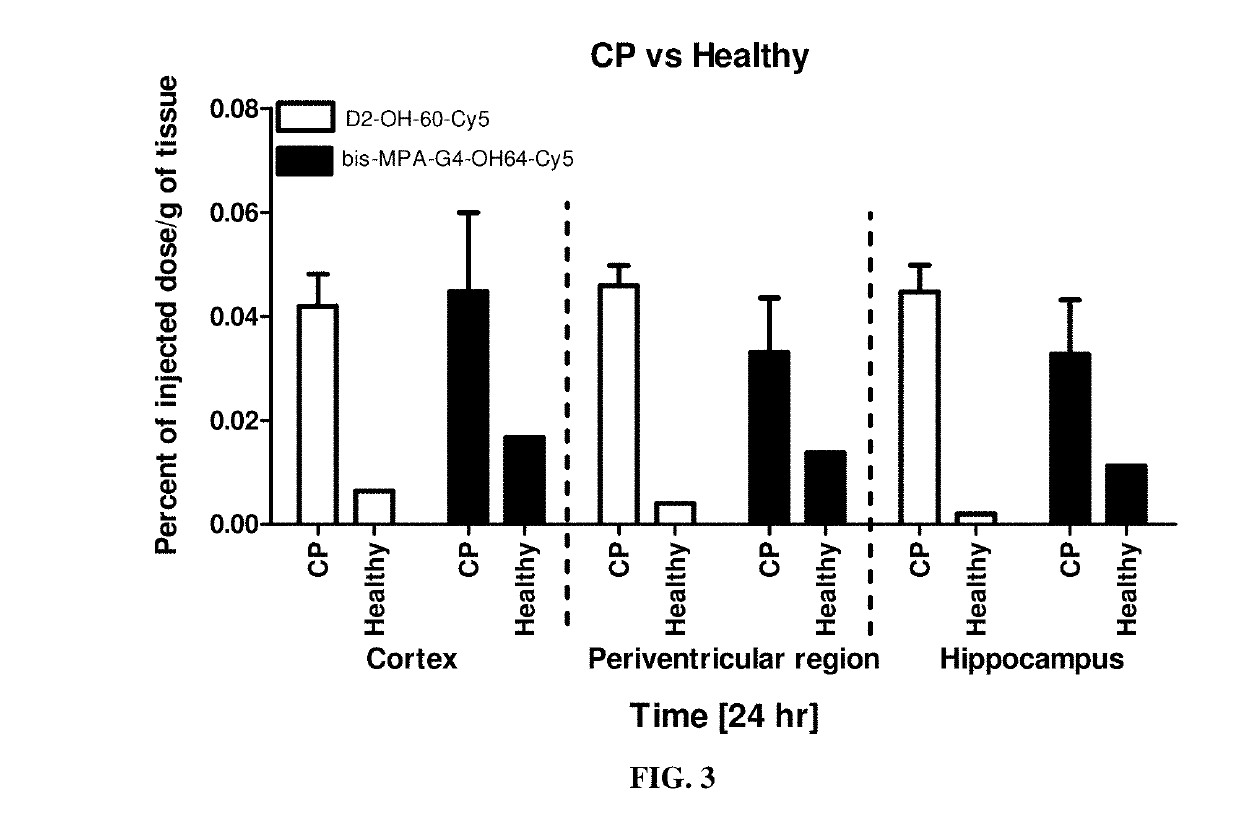Dendrimer delivery system and methods of use thereof
a delivery system and dendrimer technology, applied in the field ofmolecular delivery systems, can solve the problems of increasing the number of patients suffering from neurological diseases, posing formidable challenges to scientists and clinicians, and becoming a more serious threat to the human population
- Summary
- Abstract
- Description
- Claims
- Application Information
AI Technical Summary
Benefits of technology
Problems solved by technology
Method used
Image
Examples
example 1
of Generation 2 Highly Dense Polyhydroxy Dendrimer (D2-OH-60, Also Known as PEGOL-60)
Methods and Materials
[0215]Reagents
[0216]All the reagents were used as received unless otherwise stated. Propargyl bromide solution (80 wt % in toluene), allyl bromide, sodium hydride (60% dispersion in mineral oil), 2,2-dimethoxy-2-phenylacetophenone, 1-thioglycerol, N-(3-dimethylaminopropyl)-N′-ethylcarbodiimide hydrochloride (EDC), 4-(dimethylamino)pyridine (DMAP), N, N′-diisopropylethylamine (DIPEA), p-toluenesulfonyl chloride, tetraethylene glycol, trifluoroacetic acid (TFA), γ-(Boc-amino)butyric acid (BOC-GABA-OH), copper sulphate pentahydrate, sodium ascorbate, anhydrous dichloromethane (DCM), anhydrous tetrahydrofuran (THF), and anhydrous dimethylformamide (DMF) were purchased from Sigma-Aldrich (St. Louis, Mo., USA). Cy5-mono-NHS ester and FITC were purchased from Amersham Biosciences-GE Healthcare. All other ACS grade solvents were from Fisher Scientific. Deuterated solvents dimethylsulfox...
example 2
on of Fluorescent Imaging Agents to Dendrimeric Nanoparticles
Methods and Materials
[0239]Synthesis of Intermediates and Dendrimers
Preparation of Compound 9
[0240]To a stirring solution of dendrimer 8(620 mg, 0.08 mmoles) in DMF (10 mL) was added BOC-GABA-OH (85 mg, 0.41 mmoles) followed by the addition of EDC (160 mg, 0.83 mmoles) and DMAP (103 mg, 0.83 mmoles). The reaction mixture was then stirred at RT for 24 h. Upon completion, the reaction mixture was dialyzed against DMF for 6 h followed by water dialysis for 12 h changing water after every 4 h. The aqueous solution was then lyophilized to yield compound 9.1H NMR (500 MHz, MeOD) δ 7.94 (s, 7H), 4.54-4.48 (m, 24H), 3.88 (s, 16H), 3.75-3.63 (m, 29H), 3.60-3.53 (m, 66H), 3.53-3.47 (m, 44H), 3.47-3.42 (m, 56H), 3.41-3.36 (m, 24H), 3.33 (s, 55H), 3.26 (s, 38H), 2.71-2.45 (m, 122H), 1.78 (dd, J=20.4, 14.4 Hz, 68H), 1.39 (s, 45H). HPLC purity: 95.4%, Retention time: 18.2 minutes
Preparation of Compound 10
[0241]To a stirring solution of ...
example 3
ve Brain Distribution of D2-OH-60-Cy5 in Brain
Methods and Materials
[0251]Rabbit Model of CP and Administration of D2-OH-60-Cy5
[0252]Time pregnant New Zealand white rabbits were purchased from Robinson Services Inc. (North Carolina, U.S.A.) and arrived at the facility one week before surgery. All animals were housed under ambient conditions (22° C., 50% relative humidity, and a 12-h light / dark cycle), and necessary precautions were undertaken throughout the study to minimize pain and stress associated with the experimental treatments. Experimental procedures were approved by the Johns Hopkins University Animal Care and Use Committee (IACUC). After one week of acclimation, the pregnant rabbits underwent laparotomy on gestational day 28 (G28) and received a total of 3,200 EU of Lipopolysaccharides (LPS, E. coli serotype O127:B8, Sigma Aldrich, St Louis Mo.) injection along the wall of the uterus as previously described (Saadani-Makki, F., et al., American Journal Of Obstetrics And Gyne...
PUM
| Property | Measurement | Unit |
|---|---|---|
| molecular weight | aaaaa | aaaaa |
| molecular weight | aaaaa | aaaaa |
| molecular weight | aaaaa | aaaaa |
Abstract
Description
Claims
Application Information
 Login to View More
Login to View More - R&D
- Intellectual Property
- Life Sciences
- Materials
- Tech Scout
- Unparalleled Data Quality
- Higher Quality Content
- 60% Fewer Hallucinations
Browse by: Latest US Patents, China's latest patents, Technical Efficacy Thesaurus, Application Domain, Technology Topic, Popular Technical Reports.
© 2025 PatSnap. All rights reserved.Legal|Privacy policy|Modern Slavery Act Transparency Statement|Sitemap|About US| Contact US: help@patsnap.com



